Manufacturing Execution Systems (MES) have become critical components of modern pharmaceutical manufacturing operations, bridging the gap between planning and production floor activities. This article examines the complete MES implementation journey (from defining business requirements to post-deployment optimization).
We’ll explore implementation strategies, common challenges, cost considerations, and the technical infrastructure required for successful deployment. By the article’s conclusion, readers will understand the step-by-step process for MES implementation and how to maximize return on investment through proper planning and execution.
What is MES Implementation?
When pharmaceutical manufacturers talk about MES implementation, they’re referring to much more than installing a new software package. It’s the methodical process of planning, configuring, testing, and rolling out a Manufacturing Execution System across production facilities.
MES (Manufacturing Execution System) Implementation is a transformation project that reshapes workflows, connects disparate systems, and often requires significant organizational adaptation.
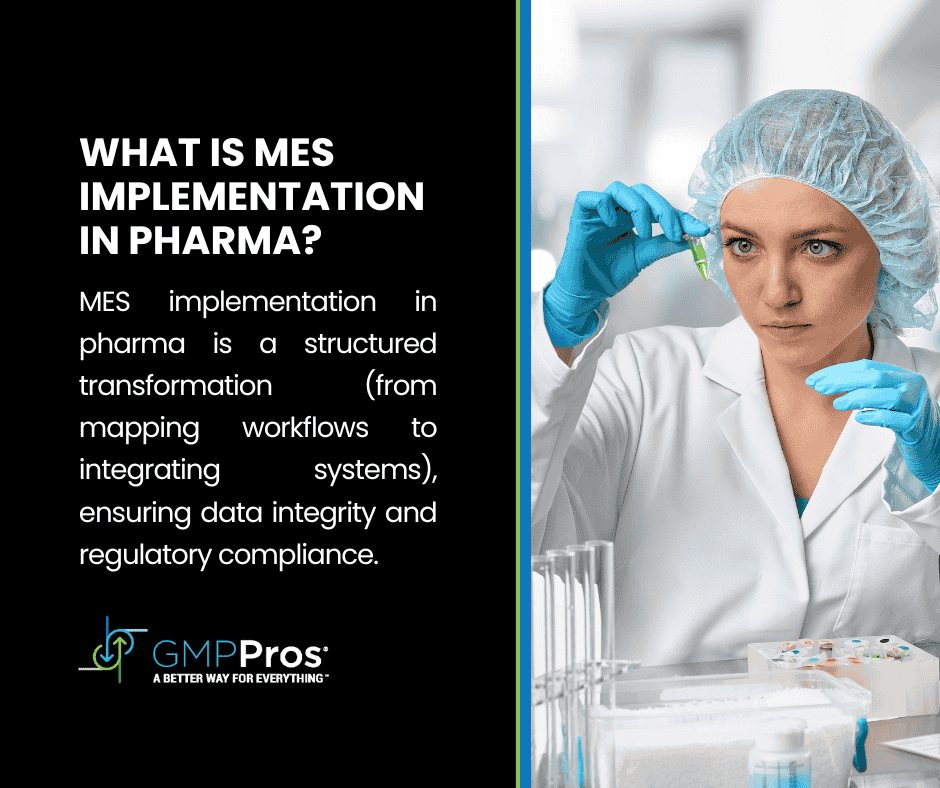
The MES sits between your high-level ERP systems and the nuts-and-bolts shop floor controls, giving you real-time production visibility, quality management tools, and automated data collection.
Recent market research shows this sector’s explosive growth; the global MES market hit $14.9 billion in 2023 and continues climbing at about 11.2% annually, according to industry experts.
For pharma companies specifically, a well-implemented MES delivers crucial advantages for meeting strict regulatory requirements. It creates a central hub for production data, enforces standardized procedures, and generates comprehensive audit trails – all critical for FDA compliance and international regulatory standards.
| MES Implementation Phase | Key Activities |
| Discovery | Process mapping, gap analysis, stakeholder interviews |
| Design | System architecture, workflow definition, integration planning |
| Build | Software configuration, customization, integration development |
| Test | Functional testing, integration testing, user acceptance testing |
| Validate | IQ/OQ/PQ protocols, validation execution, documentation |
| Deploy | User training, data migration, go-live, hypercare support |
| Optimize | Performance monitoring, continuous improvement, system expansion |
Building Your MES Implementation Business Case
Before jumping into implementation, you need solid financial justification. Companies that have successfully implemented MES systems report substantial operational improvements that translate directly to bottom-line results. A manufacturing facility in New Jersey documented a 42% reduction in batch release times after MES implementation, while a biologics manufacturer in California saw a 19% jump in OEE within six months of go-live.
The tangible value of MES typically flows through these channels:
- Tighter compliance with less effort (automated documentation, enforced procedures)
- Crystal-clear operational visibility (real-time monitoring dashboards)
- Dramatic reduction in manual paperwork (elimination of paper batch records)
- Consistent production execution (standardized digital workflows)
- Data-backed decision making (comprehensive production analytics)
| Benefit Category | Typical Impact Range |
| Production Speed | 15-45% cycle time reduction |
| Manufacturing Quality | 10-25% defect reduction |
| Equipment Utilization | 10-30% OEE improvement |
| Documentation | 50-80% paperwork reduction |
| Compliance Costs | 20-40% reduction in audit preparation time |
| Manufacturing Lead Time | 15-35% reduction |
Source: Composite data from industry case studies and implementation benchmarks
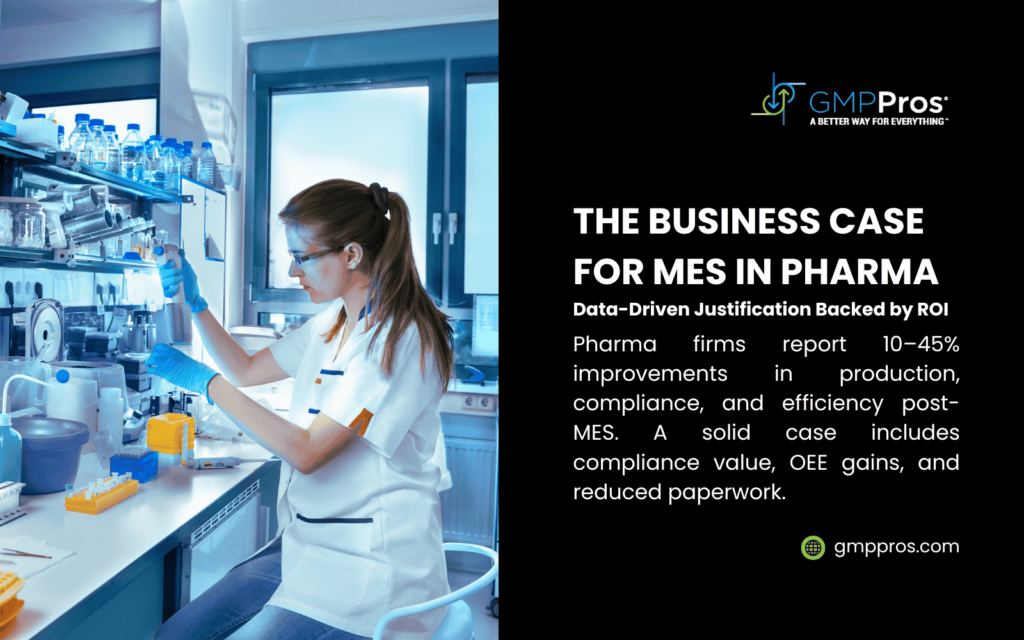
MES Implementation Steps
A methodical approach to MES implementation maximizes your chances of success. Each phase builds on the previous one, creating alignment between business goals, technical requirements, and compliance needs.
1. Project Scoping and Planning
Your implementation journey begins with defining boundaries. This crucial first phase determines what’s in and what’s out, establishes who’s responsible for what, and creates your implementation roadmap.
During scoping, you’ll need to:
- Assemble your cross-functional project team with representation from operations, quality, IT, engineering, and validation
- Document specific objectives with measurable success criteria
- Map your current production processes in detail
- Sketch future-state processes incorporating MES capabilities
- Develop a realistic project timeline with key milestones
- Identify potential roadblocks and develop contingency plans
Projects with fuzzy scope definitions frequently run into trouble. One East Coast pharmaceutical manufacturer had to reset their entire implementation after three months because of inadequate scoping, costing them over $400,000 in wasted effort.
2. MES Requirements and Vendor Selection
Next, you’ll translate your business needs into system requirements and evaluate MES platforms. This phase determines which solution best fits your unique manufacturing environment.
| Requirements Area | What to Consider |
| Functional Needs | Batch management, material tracking, electronic batch record capabilities |
| Technical Requirements | Scalability needs, performance expectations, integration points |
| Compliance Features | 21 CFR Part 11 compliance, data quality monitoring tools |
| User Experience | Interface intuitiveness, mobile capabilities, accessibility |
| Vendor Support | Implementation assistance, ongoing maintenance, upgrade frequency |
| Security Framework | Access control granularity, audit trail comprehensiveness |
When evaluating MES vendors, pharmaceutical companies should prioritize those with industry-specific experience and strong regulatory compliance capabilities. Pharma-focused MES platforms typically have pre-configured workflows for batch production, quality assurance, and regulatory documentation.
3. System Architecture and Technical Infrastructure
A robust technical foundation supports your MES implementation. Your architecture must balance performance needs, future scalability, and security requirements without breaking the bank.
| Component | What to Evaluate |
| Server Infrastructure | Processing capacity, redundancy options, virtualization capabilities |
| Client Hardware | Shop floor terminals, tablets, scanning devices, printers |
| Network Capacity | Available bandwidth, reliability, security measures |
| Database Platform | Size projections, performance needs, backup infrastructure |
| Integration Tools | API capabilities, middleware options, message queue systems |
Many pharma manufacturers now opt for cloud or hybrid MES deployments rather than traditional on-premises installations. This shift reflects the growing comfort with cloud security and the appeal of reduced infrastructure costs. However, regulated manufacturers must ensure their cloud implementations maintain proper data quality monitoring and pharma compliance controls.
4. MES Configuration and Customization
With requirements defined and infrastructure ready, you’ll configure the core MES platform to match your manufacturing processes. This typically involves:
- Building your master data structure (materials, equipment, personnel)
- Setting up production workflows and business rules
- Creating electronic forms and reports to replace paper
- Configuring system interfaces with other platforms
- Establishing user roles and permissions aligned with responsibilities
Most MES platforms offer extensive configuration options before requiring actual code customization. Smart implementers follow the “configure first, customize last” principle to minimize complexity and long-term maintenance headaches. A Midwest pharmaceutical manufacturer kept their customization under 15% and completed implementation three months ahead of schedule, while a competitor with heavy customization (over 35%) experienced repeated delays and budget overruns.
5. System Integration
The real power of MES comes from connecting it with your other manufacturing and business systems. This integration creates a seamless information flow across your organization.
| Connected System | What Gets Exchanged |
| ERP | Production orders, material consumption, batch completion data |
| LIMS | Quality specifications, test results, sample management |
| Automation Systems | Equipment data, recipe parameters, production counts |
| Historians | Long-term process data, trend information |
| Document Management | SOPs, specifications, training records |
The complexity of integration depends heavily on the state of your existing systems and data standardization. One pharma manufacturer spent nearly 40% of their implementation budget on integration because they had seven disparate systems with inconsistent data models. Another manufacturer with more standardized systems completed integration for just 22% of their total project cost.
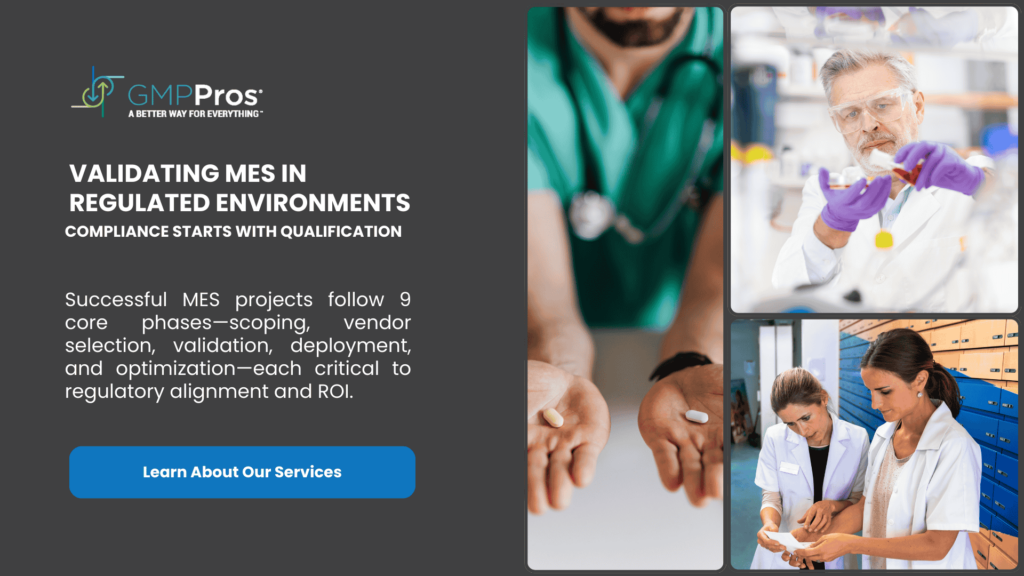
6. Validation and Qualification
For pharmaceutical manufacturers, thorough validation is not optional; it is a regulatory requirement. Your validation activities demonstrate that the MES consistently produces results meeting predetermined specifications.
A robust validation approach includes:
- Creating a comprehensive validation master plan
- Conducting system risk assessment
- Performing installation qualification (IQ)
- Completing operational qualification (OQ)
- Executing performance qualification (PQ)
- Documenting user acceptance testing (UAT)
Your validation documentation becomes critical evidence during regulatory inspections. FDA investigators increasingly focus on computerized system validation during site visits, with 18% of recent warning letters citing validation deficiencies. Companies with strong pharma regulatory compliance practices build validation activities directly into their implementation timeline rather than treating it as an afterthought.
7. Training and Change Management
Even the best-designed MES won’t deliver results if people don’t use it properly. Effective training and change management dramatically increase your odds of user adoption.
| Training Type | Best Application |
| Role-specific training | Focus on tasks relevant to each user group |
| Hands-on simulation | Practice in test environment before go-live |
| Process-based training | Teach entire workflows, not just button clicks |
| Reference materials | Quick guides for common tasks |
| Refresher sessions | Reinforce knowledge after initial go-live |
Change management should start early in your project, addressing both practical process changes and the psychological aspects of transition.
Quick Case Study: A West Coast biopharmaceutical manufacturer assigned 20% of their implementation budget to change management activities and achieved 92% user satisfaction scores within three months of go-live.
8. MES Deployment Strategy
When it’s time to flip the switch, you have several deployment strategies to consider:
- Big bang approach: Converting all processes to MES simultaneously
- Phased rollout: Implementing by functional area or production line
- Parallel processing: Running old and new systems side-by-side temporarily
Most pharmaceutical manufacturers prefer phased deployments to minimize business disruption and allow for adjustments between phases. A phased approach also distributes the validation workload more manageably across the timeline.
9. Post-Implementation Support and Optimization
After go-live, you’ll focus on stabilizing the system, addressing issues, and starting continuous improvement. This phase typically includes:
- Providing enhanced “hypercare” support during initial production use
- Monitoring system performance metrics and user adoption rates
- Addressing emerging issues and prioritizing enhancement requests
- Measuring actual benefits against your original business case
- Planning for system expansion and capability enhancement
Manufacturers who establish formal post-implementation optimization programs typically see substantially higher returns on their MES investments. One injectable product manufacturer implemented a quarterly optimization review process and achieved 32% higher productivity gains compared to their original business case projections.
MES Implementation Challenges and Solutions
Even carefully planned MES implementations face challenges. Comprehending common pitfalls helps you navigate around them.
| Challenge | Impact | Solution Approach |
| Scope expansion | Budget overruns, timeline delays | Implement strict change control, prioritize must-have vs. nice-to-have features |
| Staffing limitations | Knowledge gaps, implementation delays | Supplement internal team with experienced consultants, prioritize knowledge transfer |
| Integration hurdles | Technical complications, data quality issues | Conduct proof-of-concept testing for critical interfaces, clean data before migration |
| User resistance | Reduced system adoption, workarounds | Early stakeholder involvement, focus on WIIFM (“what’s in it for me”) |
| Compliance gaps | Validation delays, regulatory exposure | Conduct regulatory assessment during vendor selection, involve QA early |
A flexible implementation approach acknowledges these challenges and builds in contingency plans. Quick identification and resolution of issues keeps your project on track.

Real Costs of MES Implementation
Your MES implementation budget needs to account for several categories beyond just software:
| Cost Element | Typical Percentage | Notes |
| Software licensing | 15-25% | Perpetual vs. subscription models impact long-term costs |
| Hardware | 10-20% | Server infrastructure, shop floor devices, networking |
| Implementation services | 25-40% | Project management, configuration, customization |
| Integration work | 15-30% | Interface development, middleware, data mapping |
| Validation activities | 10-20% | Documentation, testing, remediation |
| Training development | 5-10% | Materials creation, delivery, reinforcement |
| Ongoing support | 15-25% annually | Maintenance, help desk, enhancements |
For a typical mid-sized pharmaceutical facility, MES implementation costs range from $1.5-3 million, with annual operating costs between 15-25% of the initial investment. However, these figures vary widely based on facility complexity, integration requirements, and customization needs.
The return on investment comes through both hard savings (reduced labor, higher yields, lower inventory) and soft benefits (improved compliance, faster decision-making).
Most pharmaceutical manufacturers see positive ROI within 12-24 months of full implementation when measuring against a comprehensive benefits model.
MES as a Compliance Cornerstone
For pharmaceutical manufacturers, regulatory compliance isn’t optional. MES systems strengthen your pharma compliance position through:
- Complete electronic batch records with tamper-evident audit trails
- Enforced workflows that prevent procedural deviations
- Material tracking that enables full product genealogy
- Automated data collection that eliminates transcription errors
- Real-time alerting when processes drift from specifications
The FDA and other regulatory bodies increasingly expect electronic systems for critical manufacturing documentation. Their guidance on data integrity specifically notes the advantages of automated systems in ensuring consistent, trustworthy records throughout product lifecycle.
Best Practices from Successful Implementations
Based on dozens of pharmaceutical MES implementations, these practices significantly improve your chances of success:
- Secure genuine executive sponsorship with regular engagement
- Define your future-state processes before selecting technology
- Build a truly cross-functional team with decision-making authority
- Develop realistic timelines based on industry benchmarks
- Manage scope boundaries rigorously throughout the project
- Integrate validation activities into each implementation phase
- Invest meaningfully in change management and training
- Test thoroughly, including under load conditions
- Clean and standardize data before migration
- Measure and communicate wins throughout the implementation
How GMP Pros Supports MES Implementation
Implementing an MES requires specialized expertise that blends manufacturing process knowledge, system configuration skills, and regulatory compliance grasping. GMP Pros offers comprehensive MES implementation services tailored specifically for pharmaceutical manufacturers.
Our unique approach includes:
- Requirements development and vendor selection guidance
- Implementation project management and execution support
- System configuration aligned with your unique processes
- Validation planning, documentation, and execution
- Integration with your existing manufacturing systems
- User training and change management programs
- Post-implementation support and optimization services
Our team’s hands-on experience with pharmaceutical MES implementations helps you avoid common pitfalls while accelerating time-to-benefit. We understand both the technical challenges and the manufacturing efficiency opportunities that MES systems present.
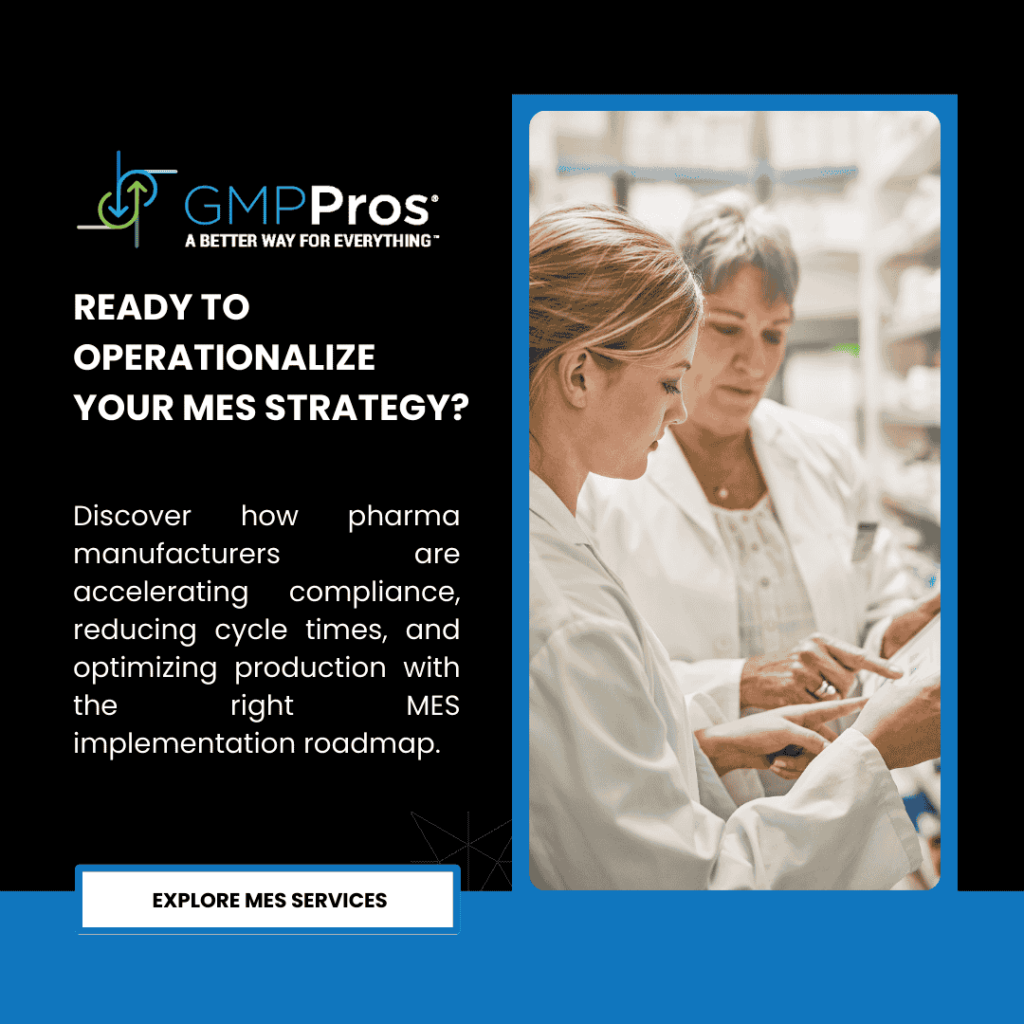
Conclusion
MES implementation represents a significant opportunity for pharmaceutical manufacturers to transform operations through improved efficiency, enhanced quality, and strengthened compliance. While implementation requires careful planning and execution, the return on investment is substantial when done right.
By following a structured methodology and partnering with experienced consultants like GMP Pros, you can navigate the complexities of MES deployment and realize the full potential of these powerful systems in your manufacturing environment.
Key Takeaways
- Approach MES implementation as a business transformation, not just a technology project
- Start with thorough planning and scoping to set proper boundaries
- Integrate with existing systems to maximize value from your MES
- Build validation into your implementation timeline from day one
- Invest appropriately in training and change management for user adoption
- Establish post-implementation optimization to continue extracting value
- Consider a partnership with experienced consultants to reduce risk
Ready to transform your manufacturing operations with MES? Contact GMP Pros to discuss your implementation needs and discover how our experienced team can guide you to a successful deployment.
References
- PharmTech. (2023). Manufacturing Execution Systems Market Analysis 2023-2030.
- International Society for Pharmaceutical Engineering. (2023). MES Implementation Benchmark Report.
- Manufacturing Enterprise Solutions Association. (2023). Business Value of MES in Pharmaceutical Manufacturing.
- Parenteral Drug Association. (2023). Computerized Systems in Pharmaceutical Manufacturing.
- FDA. (2023). Data Integrity and Compliance With CGMP Questions and Answers.
- International Society for Pharmaceutical Engineering. (2022). GAMP 5 Guide: A Risk-Based Approach to Compliant GxP Computerized Systems.
- ARC Advisory Group. (2023). MES Implementation Cost Analysis for Life Sciences.
- Pharmaceutical Manufacturing Technology Centre. (2023). Technology Implementation Benchmark Report.
- Gartner. (2023). Market Guide for Manufacturing Execution Systems in Regulated Industries.
